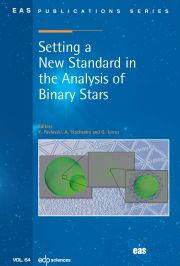Crossref Citations
This article has been cited by the following publications. This list is generated based on data provided by
Crossref.
Risquez, D.
Keil, R.
van Leeuwen, F.
and
Brown, A.G.A.
2010.
Accurate Modelling the Attitude of the Gaia Satellite.
EAS Publications Series,
Vol. 45,
Issue. ,
p.
47.
Risquez, D.
van Leeuwen, F.
and
Brown, A. G. A.
2012.
Dynamical attitude model for Gaia.
Experimental Astronomy,
Vol. 34,
Issue. 3,
p.
669.
Chavez, Joy M.
Macri, Lucas M.
and
Pellerin, Anne
2012.
BLENDING OF CEPHEIDS IN M33.
The Astronomical Journal,
Vol. 144,
Issue. 4,
p.
113.
Díaz, R. F.
Santerne, A.
Sahlmann, J.
Hébrard, G.
Eggenberger, A.
Santos, N. C.
Moutou, C.
Arnold, L.
Boisse, I.
Bonfils, X.
Bouchy, F.
Delfosse, X.
Desort, M.
Ehrenreich, D.
Forveille, T.
Lagrange, A.-M.
Lovis, C.
Pepe, F.
Perrier, C.
Queloz, D.
Ségransan, D.
Udry, S.
and
Vidal-Madjar, A.
2012.
The SOPHIE search for northern extrasolar planets.
Astronomy & Astrophysics,
Vol. 538,
Issue. ,
p.
A113.
Battaglia, Giuseppina
Helmi, Amina
and
Breddels, Maarten
2013.
Internal kinematics and dynamical models of dwarf spheroidal galaxies around the Milky Way.
New Astronomy Reviews,
Vol. 57,
Issue. 3-4,
p.
52.
Carrasco, J. M.
Catalán, S.
Jordi, C.
Tremblay, P.-E.
Napiwotzki, R.
Luri, X.
Robin, A. C.
and
Kowalski, P. M.
2014.
Gaiaphotometry for white dwarfs.
Astronomy & Astrophysics,
Vol. 565,
Issue. ,
p.
A11.
Altavilla, G.
Marinoni, S.
Pancino, E.
Galleti, S.
Ragaini, S.
Bellazzini, M.
Cocozza, G.
Bragaglia, A.
Carrasco, J. M.
Castro, A.
Di Fabrizio, L.
Federici, L.
Figueras, F.
Gebran, M.
Jordi, C.
Masana, E.
Schuster, W.
Valentini, G.
and
Voss, H.
2015.
The Gaia spectrophotometric standard stars survey: II. Instrumental effects of six ground‐based observing campaigns.
Astronomische Nachrichten,
Vol. 336,
Issue. 6,
p.
515.
Evans, Christopher J.
Simard, Luc
Takami, Hideki
Dalton, Gavin
Trager, Scott
Abrams, Don Carlos
Bonifacio, Piercarlo
Aguerri, J. Alfonso L.
Middleton, Kevin
Benn, Chris
Dee, Kevin
Sayède, Frédéric
Lewis, Ian
Pragt, Johannes
Pico, Sergio
Walton, Nic
Rey, Jeurg
Allende Prieto, Carlos
Peñate, José
Lhome, Emilie
Agócs, Tibor
Alonso, José
Terrett, David
Brock, Matthew
Gilbert, James
Schallig, Ellen
Ridings, Andy
Guinouard, Isabelle
Verheijen, Marc
Tosh, Ian
Rogers, Kevin
Lee, Martin
Steele, Iain
Stuik, Remko
Tromp, Niels
Jaskó, Attila
Carrasco, Esperanza
Farcas, Szigfrid
Kragt, Jan
Lesman, Dirk
Kroes, Gabby
Mottram, Chris
Bates, Stuart
Rodriguez, Luis Fernando
Gribbin, Frank
Delgado, José Miguel
Herreros, José Miguel
Martin, Carlos
Cano, Diego
Navarro, Ramon
Irwin, Mike
Lewis, Jim
Gonzalez Solares, Eduardo
Murphy, David
Worley, Clare
Bassom, Richard
O'Mahoney, Neil
Bianco, Andrea
Zurita, Christina
ter Horst, Rik
Molinari, Emilio
Lodi, Marcello
Guerra, José
Martin, Adrian
Vallenari, Antonella
Salasnich, Bernardo
Baruffolo, Andrea
Jin, Shoko
Hill, Vanessa
Smith, Dan
Drew, Janet
Poggianti, Bianca
Pieri, Mat
Dominquez Palmero, Lillian
and
Farina, Cecilia
2016.
Final design and progress of WEAVE: the next generation wide-field spectroscopy facility for the William Herschel Telescope.
Vol. 9908,
Issue. ,
p.
99081G.
Frémat, Y.
Altmann, M.
Pancino, E.
Soubiran, C.
Jofré, P.
Damerdji, Y.
Heiter, U.
Royer, F.
Seabroke, G.
Sordo, R.
Blanco-Cuaresma, S.
Jasniewicz, G.
Martayan, C.
Thévenin, F.
Vallenari, A.
Blomme, R.
David, M.
Gosset, E.
Katz, D.
Viala, Y.
Boudreault, S.
Cantat-Gaudin, T.
Lobel, A.
Meisenheimer, K.
Nordlander, T.
Raskin, G.
Royer, P.
and
Zorec, J.
2017.
A test field forGaia.
Astronomy & Astrophysics,
Vol. 597,
Issue. ,
p.
A10.
Benn, Chris
Dee, Kevin
Sayède, Frédéric N.
Lewis, Ian J.
Pragt, Johan
Picó, Sergio
Walton, Nicholas A.
Rey, Jeurg
Allende Prieto, Carlos
Lhomé, Émilie
Terrett, David
Brock, Matthew
Gilbert, James
Ridings, Andy
Verheijen, Marc
Tosh, Ian
Steele, Iain A.
Stuik, Remko
Kroes, Gabby
Burgal, José Alonso
Tromp, Neils
Kragt, Jan
Lesman, Dirk
Mottram, Chris
Bates, Stuart
Gribbin, Frank
Mayya, Divakara
Dalton, Gavin B.
Trager, Scott C.
Abrams, Don Carlos
Aguerri, Jose Alfonso
Bonifacio, Piercarlo
Vallenari, Antonella
Carrasco Licea, Esperanza E.
Middleton, Kevin
Jin, Shoko
Herreros, José Miguel
Delgado, Jose Miguel
Martin, Carlos
Cano Infantes, Diego
Navarro, Ramón
Irwin, Mike J.
Lewis, James
Gonzales, Eduardo
O'Mahony, Neil
Bianco, Andrea
Zurita, Christina
ter Horst, Rik
Molinari, Emilio
Lodi, Marcello
Guerra, Jose
Baruffolo, Andrea
Salasnich, Bernardo
Farkas, Szigfrid
Schallig, Ellen
Hill, Vanessa
Smith, Dan
Drew, Janet
Poggianti, Bianca
Pieri, Matthew
Domínquez, Lilian
Fariña, Cecilia
Martin, Adrian
Worley, Clare
Murphy, David
Hidalgo, Andrea
Mignot, Shan B.
Bishop, Georgia
Guest, Steve
Elswijk, Eddy
de Haan, Menno
Hanenburg, Hiddo
Izazaga-Pérez, Rafael
Peralta de Arriba, Luis
Takami, Hideki
Evans, Christopher J.
and
Simard, Luc
2018.
Construction progress of WEAVE: the next generation wide-field spectroscopy facility for the William Herschel Telescope.
p.
47.

